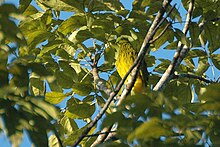Yellow Fijian Downy Pigeon
| Yellow Fijian Downy Pigeon | ||||||||||
|---|---|---|---|---|---|---|---|---|---|---|

Yellow Fijian Downy Pigeon, male |
||||||||||
| Systematics | ||||||||||
|
||||||||||
| Scientific name | ||||||||||
| Ptilinopus luteovirens | ||||||||||
| ( Hombron & Jacquinot , 1841) |
The yellow Fijian downy pigeon ( Ptilinopus luteovirens ), also known as golden fruit dove, is a species of pigeon bird that belongs to the downy pigeon . It is a small, compactly built and predominantly green-feathered species that is found on some of the Fiji Islands. The sexual dimorphism in this species is different from that of most downy pigeons.
The stock situation of the yellow Fijian downy pigeon is given as harmless ( least concern ). No subspecies are distinguished.
Appearance
The yellow Fiji downy pigeon reaches a body length of 18.5 to 21 centimeters, of which 4.9 to 6.2 centimeters are on the tail. The wing length is 11.8 to 12.4 centimeters. The beak is 1.3 to 1.45 inches long. Weight data are not yet available.
male
The head is mustard yellow from the forehead to the nape of the neck, the other feathers of the neck, mantle and elytra are greatly elongated, so that, for example, in resting birds, the elytra are almost completely covered. The individual feathers are each mustard yellow with olive-green feather edges, which creates a striking, longitudinally striped pattern. The upper tail covers are green and so long that they almost reach the end of the tail feathers. The wings and tail are pale green with yellow feather edges. The under tail-coverts and the underside of the wings are lemon yellow.
The chin is lime green and merges into olive green ear covers and a more yellowish throat. The feathers of the throat are also slightly stiffened, the feathers of the lower throat also have green feather edges, which makes this part of the body look slightly scaled. The neck and chest feathers are the same color as the top of the body, but are not as elongated. The belly is orange-yellow, the individual feathers have shiny green feather shafts. The under tail-coverts are bright sulfur yellow, the control feathers are pale yellow on the underside. The iris is yellow to gold, the orbital ring is comparatively broad and green in color. The beak is green, the wax skin is featherless, the legs and feet are emerald green.
female
The top of the body is completely dark green, only the areas around the eyes and the ear covers as well as the chin and throat are slightly lightened. The wings are dark green, while the wings are black with narrow yellow edges on the outer flags. The feathers of the large wing cover are lined in the same way.
The underside of the body is a little lighter and more yellowish than the upper side. The feathers of the chest and abdomen also have pale yellow hems that are particularly wide on the lower abdomen. The rump is pale yellow, the under tail-coverts are pale yellow with greenish feathers. The iris is yellowish brown, the orbital ring is colored like the male, the beak is green with small pale blue warts at the base of the beak. The feet and legs are green.
Distribution area and habitat
The yellow Fijian downy pigeon is found only on a few islands in Fiji , an isolated group of islands in the Southwest Pacific about 2,100 kilometers north of Auckland , New Zealand . The total coastline is 1129 kilometers. The archipelago consists of 332 islands with a total area of 18,333 square kilometers, 110 of which are inhabited. The yellow Fiji downy pigeon occurs within this archipelago on Viti Levu , the largest main island of the archipelago with 10531 square kilometers and also inhabits the islands of Ovalau , Beqa , Gau and the Waya islands bordering this island .
The habitat of the Fijian Yellow Downy Pigeon are open forests, gallery forests, and secondary forests. It also occurs in rainforests when they have tall trees and comparatively little undergrowth. Occasionally, it can also be seen near towns and villages. The altitude distribution ranges from the lowlands to at altitudes of 1200 meters.
Way of life
The Yellow Fijian Downy Pigeon usually hangs in the upper canopy area and only occasionally comes to the lower canopy area while foraging or looks for bushes. Despite the male's striking plumage, it can hardly be made out in the crown area. The presence of the male is particularly noticeable through his calls. Basically, it is a very agile bird that changes from branch to branch with short wings and sometimes lets itself hang upside down from the branches to get to fruit. At least for the females it has also been observed that they also peck insects from branches and leaves.
The reproductive biology of the Fijian yellow downy pigeon has hardly been studied. The nest is a pigeon-typical loose platform made of branches and lianas, which is built in a dense bush or a thicket of climbing plants. The clutch consists of only one single egg.
literature
- David Gibbs, Eustace Barnes and John Cox: Pigeons and Doves - A Guide to the Pigeons and Doves of the World . Pica Press, Sussex 2001, ISBN 90-74345-26-3 .
- Gerhard Rösler: The wild pigeons of the earth - free living, keeping and breeding . M. & H. Schaper Verlag, Alfeld-Hannover 1996, ISBN 3-7944-0184-0 .
